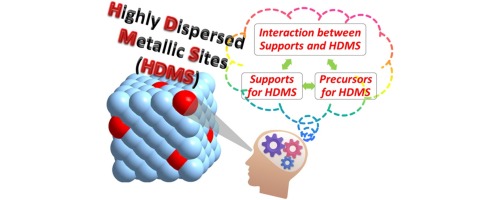当前位置:
X-MOL 学术
›
Nano Today
›
论文详情
Our official English website, www.x-mol.net, welcomes your
feedback! (Note: you will need to create a separate account there.)
Constructing and controlling of highly dispersed metallic sites for catalysis
Nano Today ( IF 13.2 ) Pub Date : 2018-04-01 , DOI: 10.1016/j.nantod.2018.02.013 Guixia Zhao , Huimin Liu , Jinhua Ye
Nano Today ( IF 13.2 ) Pub Date : 2018-04-01 , DOI: 10.1016/j.nantod.2018.02.013 Guixia Zhao , Huimin Liu , Jinhua Ye

|
Abstract It is well established that the high dispersion of active catalyst is vital to determine the performance in heterogeneous catalysis after decades of research on nanomaterials. Since the minimum scale for catalytic species is the single-atom metal with isolated metal atoms singly dispersed on, and/or coordinated with the surface atoms of some suitable supports, explosive growth of research on atomically dispersed metal catalysts has emerged especially in frontier heterogeneous catalysis. Such highly dispersed metallic sites (HDMS) imitate the function of site-directed mutagenesis in enzymology, not only maximizing the efficiency of metal atom of interest, but also offering a possibility to achieve the highest catalytic activity and selectivity and make up the gap between heterogeneous and homogeneous catalysis. However, the formidable challenge lies in that with the decreasing size of metal particles or the decreased coordination of metal atoms, the surface free energy of metals is significantly increased, which would lead to serious aggregation of the intended single-atom dispersed catalysts. Therefore, appropriate approaches to construct HDMS and control the HDMS in good homogeneity are importantly necessary to realize the fantastic catalytic activity of HDMS. Problems lie in how to synthesize precisely site-isolated supported metals and how to make sure the metals bond selectively to specific support surface sites. In this review, we aim to assess the above issues via summarizing the key recent progress on HDMS constructing and controlling in terms of the supports and metal precursors engineering, as well as the known interactions between the support and HDMS. We believe that the summary and discussion in the review will lead to a better understanding of HDMS configuration and constructing, and even shed light on novel design for new HDMS based on the discovered interactions between the support and HDMS. We also give a prospect for the future research on HDMS, with emphasizing on the emergence of new fabrication for HDMS with improved catalysts’ thermal stability and possibility for industrial application.
中文翻译:

用于催化的高度分散金属位点的构建和控制
摘要 经过数十年的纳米材料研究,活性催化剂的高分散性对于确定多相催化性能至关重要。由于催化物种的最小规模是单原子金属,孤立的金属原子单独分散和/或与一些合适载体的表面原子配位,因此原子分散金属催化剂的研究呈爆炸式增长,尤其是在前沿的多相催化领域. 这种高度分散的金属位点 (HDMS) 模仿了酶学中定点诱变的功能,不仅最大限度地提高了目标金属原子的效率,而且为实现最高催化活性和选择性提供了可能,弥补了非均相之间的差距。和均相催化。然而,严峻的挑战在于,随着金属颗粒尺寸的减小或金属原子配位的减少,金属的表面自由能显着增加,这将导致预期的单原子分散催化剂严重聚集。因此,构建 HDMS 并控制 HDMS 具有良好均匀性的适当方法对于实现 HDMS 出色的催化活性是非常必要的。问题在于如何精确合成位点隔离的支撑金属以及如何确保金属选择性地结合到特定的支撑表面位点。在这篇综述中,我们旨在通过总结在支撑和金属前驱体工程方面的 HDMS 构建和控制的关键最新进展,以及支撑和 HDMS 之间已知的相互作用来评估上述问题。我们相信,审查中的总结和讨论将有助于更好地理解 HDMS 的配置和构造,甚至可以根据已发现的支架和 HDMS 之间的相互作用,阐明新 HDMS 的新颖设计。我们还对 HDMS 的未来研究进行了展望,强调了 HDMS 新制造的出现,具有改进的催化剂热稳定性和工业应用的可能性。
更新日期:2018-04-01
中文翻译:

用于催化的高度分散金属位点的构建和控制
摘要 经过数十年的纳米材料研究,活性催化剂的高分散性对于确定多相催化性能至关重要。由于催化物种的最小规模是单原子金属,孤立的金属原子单独分散和/或与一些合适载体的表面原子配位,因此原子分散金属催化剂的研究呈爆炸式增长,尤其是在前沿的多相催化领域. 这种高度分散的金属位点 (HDMS) 模仿了酶学中定点诱变的功能,不仅最大限度地提高了目标金属原子的效率,而且为实现最高催化活性和选择性提供了可能,弥补了非均相之间的差距。和均相催化。然而,严峻的挑战在于,随着金属颗粒尺寸的减小或金属原子配位的减少,金属的表面自由能显着增加,这将导致预期的单原子分散催化剂严重聚集。因此,构建 HDMS 并控制 HDMS 具有良好均匀性的适当方法对于实现 HDMS 出色的催化活性是非常必要的。问题在于如何精确合成位点隔离的支撑金属以及如何确保金属选择性地结合到特定的支撑表面位点。在这篇综述中,我们旨在通过总结在支撑和金属前驱体工程方面的 HDMS 构建和控制的关键最新进展,以及支撑和 HDMS 之间已知的相互作用来评估上述问题。我们相信,审查中的总结和讨论将有助于更好地理解 HDMS 的配置和构造,甚至可以根据已发现的支架和 HDMS 之间的相互作用,阐明新 HDMS 的新颖设计。我们还对 HDMS 的未来研究进行了展望,强调了 HDMS 新制造的出现,具有改进的催化剂热稳定性和工业应用的可能性。











































 京公网安备 11010802027423号
京公网安备 11010802027423号